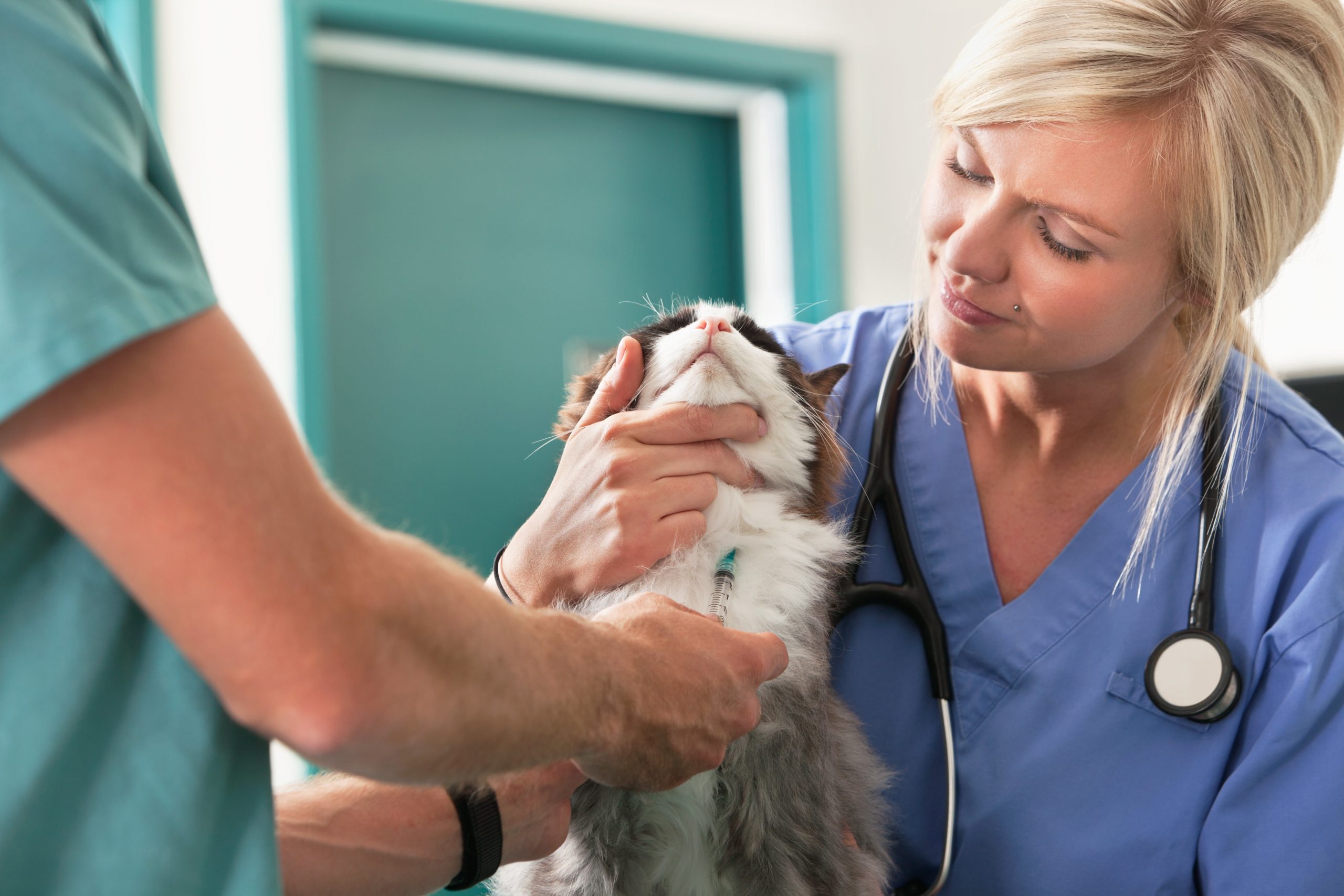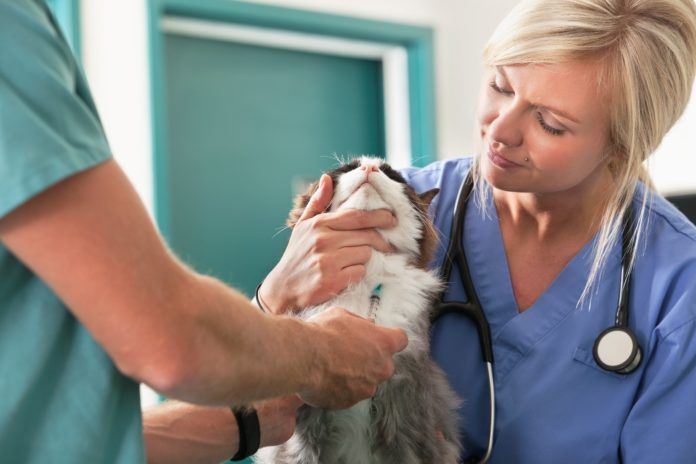Dreamstime.com

The average cat has about two ounces of blood coursing through her arteries, veins and capillaries for every two pounds of body weight. Like human blood, feline blood is a blend of red cells (erythrocytes); white cells (leukocytes); tiny disk-shaped bodies called platelets; and a colorless fluid (plasma) in which these components and other life-supporting ingredients — such as hormones, proteins and salts — are suspended.
The primary function of this normally rich, red fluid is to transport oxygen and nutrients to the tissues throughout a cat’s body and to carry carbon dioxide and wastes away from those tissues. In addition, however, circulating blood in cats as well as in humans plays an indispensable role in such life-sustaining processes as cell development, tissue repair and the warding off of infection.
Why evaluation is important
Considering the various roles performed by this life-sustaining fluid, few veterinarians would dispute the wisdom of having your cat’s blood periodically evaluated to make sure that all of its components are present and that it is functioning properly. Veterinarians generally agree that young and apparently healthy cats do not need to have their blood routinely tested.
However, says Elizabeth Rozanski, DVM, associate professor of emergency and critical care in the department of clinical sciences at Tufts, “When a cat reaches middle age — seven or eight years old — it’s a good idea to have a baseline test done. After that, it depends to an extent on how the cat is feeling.”
Yearly for the aging cat
Nevertheless, most veterinarians agree that an annual test should be considered for all elderly cats — those older than 10 or 11 years of age — and for any cat who is about to be anesthetized for surgery of any kind. (“For example, a 12-year-old cat with significant dental disease is a cat that should absolutely have a blood test done before surgery,” notes Dr. Rozanski.)
A thorough blood evaluation is also advisable for a kitten who will be receiving her first vaccination series, as well for any cat showing such signs of illness as fever, weight loss, vomiting, diarrhea, increased thirst or unusually frequent urination.
A blood test entails the withdrawal of a half-teaspoon or so of an animal’s blood, usually from one of the two jugular veins, which run down the underside of a cat’s neck, or from a vein in one of her legs. “Taking the blood doesn’t hurt a cat very much, although it may be uncomfortable,” says Dr. Rozanski. “Some cats will wiggle a lot; others will just sit there quietly. It depends on their personalities.”
The test that is most commonly done evaluates the blood sample in two separate processes: a complete blood count (CBC) and a blood chemistry panel. According to Dr. Rozanski, this component of a blood test can reveal a wide array of disorders. “Leukemia, anemia, the presence of red blood parasites — we can detect all of that with a CBC,” she notes.
What the CBC will show
The CBC (also known as a hemogram) includes the following measurements and evaluations:
- A red blood cell count measures the actual number of red cells in a given amount of blood and discerns any abnormalities in their shape, size or color. The amount of hemoglobin — a substance that carries oxygen throughout the bloodstream — is also assessed.
- A white blood cell count evaluates and counts the number of leukocytes (including lymphocytes, neutrophils, monocytes, eosinophils and basophils), all of which are produced in the bone marrow or other tissues and play various roles in attacking and destroying disease-causing organisms. A high white cell count may indicate, for example, that an animal is harboring an infection, is under stress, or is affected by a serious and chronic illness, such as leukemia.
- A platelet count measures the concentration of disk-shaped blood cells (thrombocytes) that promote blood clotting.
- A packed cell volume (hematocrit) reveals the concentration of red blood cells in the plasma. A low red cell concentration might indicate that the animal is anemic — either its bone marrow isn’t producing the cells in sufficient number or they are somehow being lost or destroyed. A high concentration could mean that the cat is dehydrated.
The role of chemistry panels
The other blood test component — the chemistry panel — focuses on the chemicals that are suspended in the clear, watery content (serum) of the blood after it has been separated from the blood cells and clotting proteins.
In these tests, the presence of a dozen or more substances — including blood urea nitrogen (BUN) and creatinine, chemicals that are normally found in excreted urine — are measured. The chemistry panel is valuable in assessing a wide range of health-determining factors.
For example, it can reveal problems in an animal’s organ function and can determine whether the blood is appropriately stocked with electrolytes — chemical compounds that regulate the exchange of electrical charges across cell membranes.
Abnormally low or high blood levels of various substances may indicate damage or disease involving the kidneys, liver, muscles or glands. For example:
- The chemistry panel measures the protein levels in blood plasma. Low levels of proteins suggest, for example, the possibility of liver, kidney, or gastrointestinal malfunction, while high levels may indicate the presence of infection, chronic inflammation or some types of cancer.
- High blood levels of BUN and creatinine can indicate that an animal’s kidneys are not adequately filtering metabolic wastes.
- High levels of alanine aminotransferase and other enzymes may indicate liver damage.
- Abnormal calcium levels may indicate the presence of tumors, kidney disease and other disorders.
- High levels of blood sugar (glucose) may indicate diabetes.
Low levels of potassium may explain an animal’s chronic lethargy or lack of muscle control and may be associated with kidney disease or diabetes.
- In addition, a blood chemistry panel measures total protein content, including albumin and globulins. High or low blood levels of these proteins can influence many bodily processes, including the ability to retain water and to defend against infection.
An abundance of information
The value of basic bloodwork is indisputable and — along with patient history, a thorough physical exam and urinalysis — is well established as a fundamental element of modern veterinary practice. Most veterinarians, therefore, will start the evaluation of any sick cat with the basic screen because the procedure is noninvasive and provides an abundance of information.
In some cases, a routine CBC or blood chemistry panel may be inadequate for a specific purpose, such as looking for infection in a specific organ, gauging an animal’s endocrine function, or testing for systemic infection with FIV (feline immunodeficiency virus), FeLV (feline leukemia virus) and other specific disease agents.
These and other such specialized tests may require a cat’s blood sample to be shipped to a specialized lab, in which case the results may not come back for days or weeks, while the findings of a routine CBC or blood chemistry panel can be available almost immediately. According to Dr. Rozanski, a routine blood test will typically cost between $100 and $150, although this price may vary regionally. — Tom Ewing




